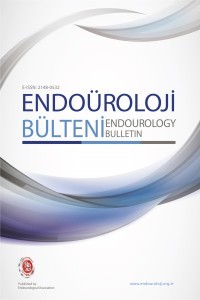Ağrı ve anksiyetenin ağrı algısı ve ekstrakorporeal şok dalgası litotripsinin sonucu üzerindeki etkisi
anksiyete, ekstrakorporeal şok dalgası litotripsi, ağrı algısı, üriner taş hastalığı
The Influence of Pain and Anxiety on the Pain Perception and Outcome of Extracorporeal Shockwave Lithotripsy
___
- 1. Türk C, Petřík A, Sarica K, et al. EAU Guidelines on Diagnosis and Conservative Management of Urolithiasis. Eur Urol. 2016 Mar;69(3):468-74. https://doi.org/10.1016/j.eururo.2015.07.040.
- 2. Torricelli FC, Danilovic A, Vicentini FC, et al: Extracorporeal shock wave lithotripsy in the treatment of renal and ureteral stones. Rev Assoc Med Bras 2015;61:65–71. https://doi.org/10.1590/1806-9282.61.01.065.
- 3. Ucer O, Ceylan Y, Ekren F, Ozan E, Muezzinoglu T: Effect of anxiety and pain on success of shockwave lithotripsy (SWL) for treatment of proximal ureteral and renal pelvic stones. Urolithiasis 2016;44:559–564. https://doi.org/10.1007/s00240-016-0879-4
- 4. Vergnolles M, Wallerand H, Gadrat F, et al: Predictive risk factors for pain during extracorporeal shockwave lithotripsy. J Endourol 2009;23:2021–2027. https://doi.org/10.1089/end.2009.0111
- 5. Hwang I, Jung SI, Kim KH, et al: Factors influencing the failure of extracorporeal shock wave lithotripsy with Piezolith 3000 in the management of solitary ureteral stone. Urolithiasis 2014;42:263–267. https://doi.org/10.1007/s00240-014-0641-8
- 6. Torrecilla Ortiz C, Rodriguez Blanco LL, Diaz Vicente F, et al. [Extracorporeal shockwave lithotripsy: Anxiety and pain perception]. Actas Urol Espan 2000;24:163-8. https://doi.org/10.1016/s0210-4806(00)72423-5
- 7. Fillingim RB. Individual differences in pain responses. Curr Rheumatol Reports 2005;7:342-7. https://doi.org/10.1007/s11926-005-0018-7
- 8. El-Nahas AR, El-Assmy AM, Mansour O, et al. A prospective multivariate analysis of factors predicting stone disintegration by extracorporeal shock wave lithotripsy: The value of high-resolution noncontrast computed tomography. Eur Urol 2007;51:1688-93. https://doi.org/10.1016/j.eururo.2006.11.048
- 9. Franceschi A, Rozada P, Galerneau V, et al. [Pain and extracorporeal lithotripsy for calculi of the upper urinary tract]. Ann Urol (Paris) 1991;25:131-7.
- 10. Tokgoz H, Hanci V, Turksoy O, et al. Pain perception during shock wave lithotripsy: Does it correlate with patient and stone characteristics? J Chin Med Assoc 2010;73:477-82. https://doi.org/10.1016/S1726-4901(10)70102-7
- 11. Spielberger CD, Gorsuch RL, Lushene R, et al. Manual for the State-Trait Anxiety Inventory. Consulting Psychologists Press. 1970.
- 12. Zigmond AS, Snaith RP. The hospital anxiety and depression scale. Acta Psychiatr Scand 1983;67:361-70. https://doi.org/10.1111/j.1600-0447.1983.tb09716.x
- 13. Altok M, Akpinar A, Güneş M, et al. Do anxiety, stress, or depression have any impact on pain perception during shock wave lithotripsy? Can Urol Assoc J. 2016 May-Jun;10(5-6):E171-E174. https://doi.org/10.5489/cuaj.3445
- 14. Berwin JT, El-Husseiny T, Papatsoris AG, et al. Pain in extracorporeal shock wave lithotripsy. Urol Res 2009;37:51-3. https://doi.org/10.1007/s00240-009-0171-y
- 15. Salinas AS, Lorenzo-Romero J, Segura M, et al. Factors determining analgesic and sedative drug requirements during extracorporeal shock wave lithotripsy. Urol Int 1999;63:92-101. https://doi.org/10.1159/000030425
- 16. Tailly GG, Marcelo JB, Schneider IA, et al. Patient-controlled analgesia during SWL treatments. J Endourol 2001;15:465-71. https://doi.org/10.1089/089277901750299230
- 17. Kim H, Neubert JK, Rowan JS, et al. Comparison of experimental and acute clinical pain responses in humans as pain phenotypes. J Pain 2004;5:377-84. https://doi.org/10.1016/j.jpain.2004.06.003
- Yayın Aralığı: Yılda 3 Sayı
- Başlangıç: 2020
- Yayıncı: ENDOÜROLOJİ DERNEĞİ
Perkütan Nefrolitotomi Ameliyatında Taşsızlığın İntraoperatif Değerlendirilmesi: Cerrahın Gözü
Mehmet Yiğit YALÇIN, Batuhan ERGANİ, Taha ÇETİN, Mustafa KARABIÇAK, Mert Hamza ÖZBİLEN, Çağdaş BİLDİRİCİ, Erkin KARACA, Mehmet YOLDAŞ, Erdem KISA, Tufan Suel ÖZGEN, Gökhan KOÇ, Özgür ÇAKMAK, Hayal BOYACIOĞLU, Yusuf Özlem İLBEY
Harun ÖZDEMİR, Emin Taha KESKİN, Merve ŞAM ÖZDEMİR, Metin SAVUN, Halil Lütfi CANAT, Abdülmüttalip ŞİMŞEK
Pelvimetrik Ölçümlerin Açık Retropubik Radikal Prostatektomi Operasyon Süresi Üzerine Etkileri
Mustafa AYDIN, Lokman İRKİLATA, Mustafa Koray KIRDAĞ, Uğur ÖZTÜRK, Mehmet ÖZEN, Emrah KÜÇÜK, Hakan YILDIZ, Reha ORDULU, Mustafa Kemal ATİLLA
Osman Raif KARABACAK, Fatih SANDIKÇI, Hakan SALTAŞ, Alper DİLLİ, Kürşad ZENGİN, Fatih YALÇINKAYA, Ümit Yaşar AYAZ
